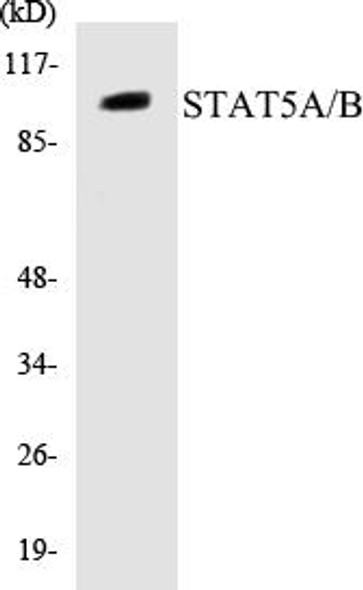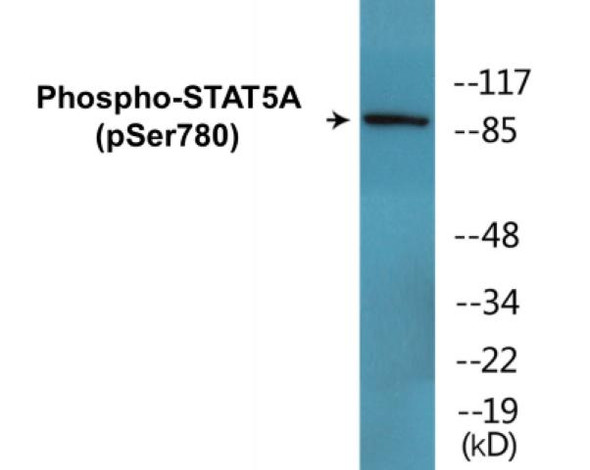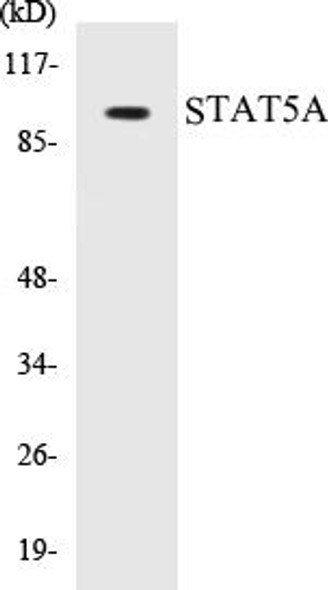Description
STAT5A/B (Phospho-Ser731)Colorimetric Cell-Based ELISA Kit
The STAT5A/B (phospho Ser731) Colorimetric Cell-Based ELISA Kit is a cutting-edge tool designed for the precise measurement of phosphorylated STAT5A/B (at Ser731) levels in cell lysates. This kit offers superior sensitivity and specificity, ensuring accurate and consistent results for a variety of research applications.STAT5A/B is a key transcription factor involved in numerous cellular processes, including proliferation, differentiation, and survival. Activation of STAT5A/B through phosphorylation at Ser731 is crucial for its function in signal transduction pathways.
Dysregulation of STAT5A/B signaling is associated with various diseases, making it a valuable target for research and drug development efforts.This innovative ELISA kit is user-friendly and provides robust performance, making it an essential tool for studying the role of STAT5A/B (phospho Ser731) in cellular signaling pathways and disease pathogenesis. Order yours today to advance your research endeavors.
| Product Name: | STAT5A/B (Phospho-Ser731) Colorimetric Cell-Based ELISA |
| Product Code: | CBCAB01253 |
| ELISA Type: | Cell-Based |
| Target: | STAT5A/B (Phospho-Ser731) |
| Reactivity: | Human, Mouse, Rat |
| Dynamic Range: | > 5000 Cells |
| Detection Method: | Colorimetric 450 nm |
| Format: | 2 x 96-Well Microplates |
The STAT5A/B (Phospho-Ser731) Colorimetric Cell-Based ELISA Kit is a convenient, lysate-free, high throughput and sensitive assay kit that can detect STAT5A/B protein phosphorylation and expression profile in cells. The kit can be used for measuring the relative amounts of phosphorylated STAT5A/B in cultured cells as well as screening for the effects that various treatments, inhibitors (ie. siRNA or chemicals), or activators have on STAT5A/B phosphorylation.
Qualitative determination of STAT5A/B (Phospho-Ser731) concentration is achieved by an indirect ELISA format. In essence, STAT5A/B (Phospho-Ser731) is captured by STAT5A/B (Phospho-Ser731)-specific primary (1ø) antibodies while the HRP-conjugated secondary (2ø) antibodies bind the Fc region of the 1ø antibody. Through this binding, the HRP enzyme conjugated to the 2ø antibody can catalyze a colorimetric reaction upon substrate addition. Due to the qualitative nature of the Cell-Based ELISA, multiple normalization methods are needed:
| 1. | A monoclonal antibody specific for human GAPDH is included to serve as an internal positive control in normalizing the target absorbance values. |
| 2. | Following the colorimetric measurement of HRP activity via substrate addition, the Crystal Violet whole-cell staining method may be used to determine cell density. After staining, the results can be analysed by normalizing the absorbance values to cell amounts, by which the plating difference can be adjusted. |
| Database Information: | Gene ID: 6777, UniProt ID: P42229/P51692, OMIM: 245590/604260, Unigene: Hs.714309 |
| Gene Symbol: | STAT5A/STAT5B |
| Sub Type: | Phospho |
| UniProt Protein Function: | STAT5A: transcription factor of the STAT family. Phosphorylated and activated by receptor-associated kinases downstream of many cytokines and growth-factor receptors. Activation of this protein in myeloma and lymphoma associated with a TEL/JAK2 fusion protein is essential for the tumorigenesis. Induces the expression of BCL2L1/BCL-X(L) in the mouse, suggesting an antiapoptotic function of this protein. Forms homo- or heterodimers that translocate into the nucleus where they regulate transcription. Two alternatively spliced isoforms have been described. |
| UniProt Protein Details: | Protein type:DNA-binding; Transcription factor; Motility/polarity/chemotaxis; Oncoprotein Chromosomal Location of Human Ortholog: 17q11.2 Cellular Component: nucleoplasm; cytosol Molecular Function:signal transducer activity; protein binding; transcription factor activity Biological Process: lactation; succinate metabolic process; oxaloacetate metabolic process; peptidyl-tyrosine phosphorylation; positive regulation of interleukin-2 biosynthetic process; T cell differentiation in the thymus; positive regulation of multicellular organism growth; female pregnancy; positive regulation of mitotic cell cycle; fatty acid metabolic process; positive regulation of activated T cell proliferation; 2-oxoglutarate metabolic process; positive regulation of natural killer cell differentiation; sequestering of lipid; natural killer cell differentiation; allantoin metabolic process; negative regulation of mast cell apoptosis; luteinization; development of secondary male sexual characteristics; regulation of steroid metabolic process; creatinine metabolic process; T cell homeostasis; positive regulation of gamma-delta T cell differentiation; Peyer's patch development; isoleucine metabolic process; negative regulation of erythrocyte differentiation; transcription, DNA-dependent; regulation of multicellular organism growth; citrate metabolic process; valine metabolic process; development of secondary female sexual characteristics; positive regulation of natural killer cell mediated cytotoxicity; JAK-STAT cascade; creatine metabolic process; regulation of transcription from RNA polymerase II promoter; regulation of epithelial cell differentiation; positive regulation of B cell differentiation; positive regulation of transcription from RNA polymerase II promoter; taurine metabolic process; positive regulation of inflammatory response |
| NCBI Summary: | The protein encoded by this gene is a member of the STAT family of transcription factors. In response to cytokines and growth factors, STAT family members are phosphorylated by the receptor associated kinases, and then form homo- or heterodimers that translocate to the cell nucleus where they act as transcription activators. This protein is activated by, and mediates the responses of many cell ligands, such as IL2, IL3, IL7 GM-CSF, erythropoietin, thrombopoietin, and different growth hormones. Activation of this protein in myeloma and lymphoma associated with a TEL/JAK2 gene fusion is independent of cell stimulus and has been shown to be essential for tumorigenesis. The mouse counterpart of this gene is found to induce the expression of BCL2L1/BCL-X(L), which suggests the antiapoptotic function of this gene in cells. Alternatively spliced transcript variants have been found for this gene. [provided by RefSeq, Dec 2013] |
| UniProt Code: | P42229 |
| NCBI GenInfo Identifier: | 1174462 |
| NCBI Gene ID: | 6776 |
| NCBI Accession: | P42229.1 |
| UniProt Secondary Accession: | P42229,Q1KLZ6, |
| UniProt Related Accession: | P42229 |
| Molecular Weight: | |
| NCBI Full Name: | Signal transducer and activator of transcription 5A |
| NCBI Synonym Full Names: | signal transducer and activator of transcription 5A |
| NCBI Official Symbol: | STAT5A |
| NCBI Official Synonym Symbols: | MGF; STAT5 |
| NCBI Protein Information: | signal transducer and activator of transcription 5A |
| UniProt Protein Name: | Signal transducer and activator of transcription 5A |
| Protein Family: | Signal transducer and activator of transcription |
| UniProt Gene Name: | STAT5A |
| UniProt Entry Name: | STA5A_HUMAN |
| Component | Quantity |
| 96-Well Cell Culture Clear-Bottom Microplate | 2 plates |
| 10X TBS | 24 mL |
| Quenching Buffer | 24 mL |
| Blocking Buffer | 50 mL |
| 15X Wash Buffer | 50 mL |
| Primary Antibody Diluent | 12 mL |
| 100x Anti-Phospho Target Antibody | 60 µL |
| 100x Anti-Target Antibody | 60 µL |
| Anti-GAPDH Antibody | 60 µL |
| HRP-Conjugated Anti-Rabbit IgG Antibody | 12 mL |
| HRP-Conjugated Anti-Mouse IgG Antibody | 12 mL |
| SDS Solution | 12 mL |
| Stop Solution | 24 mL |
| Ready-to-Use Substrate | 12 mL |
| Crystal Violet Solution | 12 mL |
| Adhesive Plate Seals | 2 seals |
The following materials and/or equipment are NOT provided in this kit but are necessary to successfully conduct the experiment:
- Microplate reader able to measure absorbance at 450 nm and/or 595 nm for Crystal Violet Cell Staining (Optional)
- Micropipettes with capability of measuring volumes ranging from 1 µL to 1 ml
- 37% formaldehyde (Sigma Cat# F-8775) or formaldehyde from other sources
- Squirt bottle, manifold dispenser, multichannel pipette reservoir or automated microplate washer
- Graph paper or computer software capable of generating or displaying logarithmic functions
- Absorbent papers or vacuum aspirator
- Test tubes or microfuge tubes capable of storing ≥1 ml
- Poly-L-Lysine (Sigma Cat# P4832 for suspension cells)
- Orbital shaker (optional)
- Deionized or sterile water
*Note: Protocols are specific to each batch/lot. For the correct instructions please follow the protocol included in your kit.
| Step | Procedure |
| 1. | Seed 200 µL of 20,000 adherent cells in culture medium in each well of a 96-well plate. The plates included in the kit are sterile and treated for cell culture. For suspension cells and loosely attached cells, coat the plates with 100 µL of 10 µg/ml Poly-L-Lysine (not included) to each well of a 96-well plate for 30 minutes at 37 °C prior to adding cells. |
| 2. | Incubate the cells for overnight at 37 °C, 5% CO2. |
| 3. | Treat the cells as desired. |
| 4. | Remove the cell culture medium and rinse with 200 µL of 1x TBS, twice. |
| 5. | Fix the cells by incubating with 100 µL of Fixing Solution for 20 minutes at room temperature. The 4% formaldehyde is used for adherent cells and 8% formaldehyde is used for suspension cells and loosely attached cells. |
| 6. | Remove the Fixing Solution and wash the plate 3 times with 200 µL 1x Wash Buffer for five minutes each time with gentle shaking on the orbital shaker. The plate can be stored at 4 °C for a week. |
| 7. | Add 100 µL of Quenching Buffer and incubate for 20 minutes at room temperature. |
| 8. | Wash the plate 3 times with 1x Wash Buffer for 5 minutes each time. |
| 9. | Add 200 µL of Blocking Buffer and incubate for 1 hour at room temperature. |
| 10. | Wash 3 times with 200 µL of 1x Wash Buffer for 5 minutes each time. |
| 11. | Add 50 µL of 1x primary antibodies Anti-STAT5A/B (Phospho-Ser731) Antibody, Anti-STAT5A/B Antibody and/or Anti-GAPDH Antibody) to the corresponding wells, cover with Parafilm and incubate for 16 hours (overnight) at 4 °C. If the target expression is known to be high, incubate for 2 hours at room temperature. |
| 12. | Wash 3 times with 200 µL of 1x Wash Buffer for 5 minutes each time. |
| 13. | Add 50 µL of 1x secondary antibodies (HRP-Conjugated AntiRabbit IgG Antibody or HRP-Conjugated Anti-Mouse IgG Antibody) to corresponding wells and incubate for 1.5 hours at room temperature. |
| 14. | Wash 3 times with 200 µL of 1x Wash Buffer for 5 minutes each time. |
| 15. | Add 50 µL of Ready-to-Use Substrate to each well and incubate for 30 minutes at room temperature in the dark. |
| 16. | Add 50 µL of Stop Solution to each well and read OD at 450 nm immediately using the microplate reader. |
(Additional Crystal Violet staining may be performed if desired – details of this may be found in the kit technical manual.)






